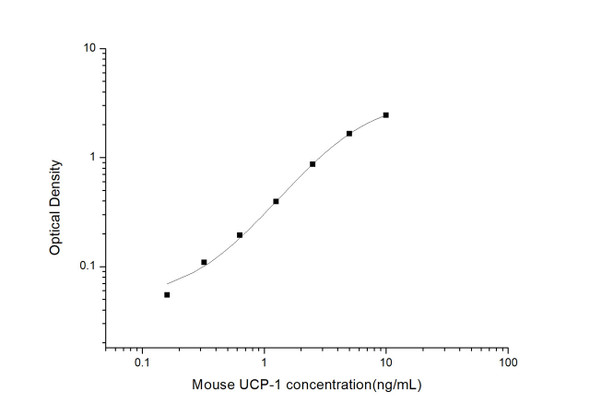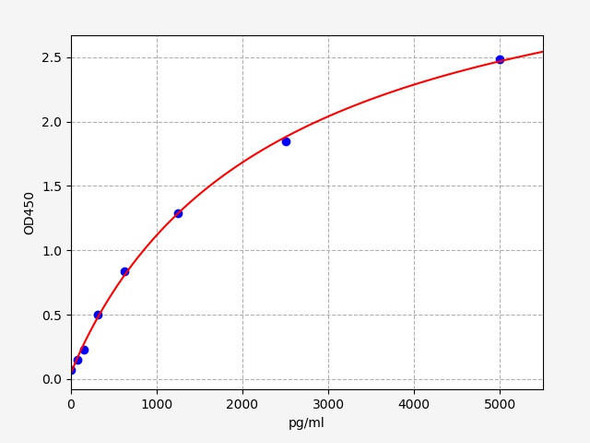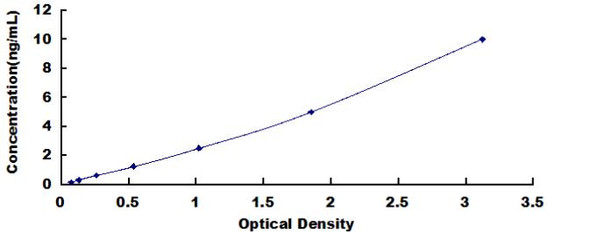Human Signal Transduction ELISA Kits
Human UCP-1 (Uncoupling Protein 1, Mitochondrial) ELISA Kit (HUES02661)
- SKU:
- HUES02661
- Product Type:
- ELISA Kit
- Size:
- 96 Assays
- Uniprot:
- P25874
- Sensitivity:
- 0.09ng/mL
- Range:
- 0.16-10ng/mL
- ELISA Type:
- Sandwich
- Synonyms:
- SLC25A7, Thermogenin
- Reactivity:
- Human
- Sample Type:
- Serum, plasma and other biological fluids
- Research Area:
- Signal Transduction
Description
| Assay type: | Sandwich |
| Format: | 96T |
| Assay time: | 4.5h |
| Reactivity: | Human |
| Detection Method: | Colormetric |
| Detection Range: | 0.16-10 ng/mL |
| Sensitivity: | 0.10 ng/mL |
| Sample Volume Required Per Well: | 100µL |
| Sample Type: | Serum, plasma and other biological fluids |
| Specificity: | This kit recognizes Human UCP-1 in samples. No significant cross-reactivity or interference between Human UCP-1 and analogues was observed. |
This ELISA kit uses Sandwich-ELISA as the method. The micro ELISA plate provided in this kit has been pre-coated with an antibody specific to Human UCP-1. Standards or samples are added to the appropriate micro ELISA plate wells and combined with the specific antibody. Then a biotinylated detection antibody specific for Human UCP-1 and Avidin-Horseradish Peroxidase (HRP) conjugate are added to each micro plate well successively and incubated. Free components are washed away. The substrate solution is added to each well. Only those wells that contain Human UCP-1, biotinylated detection antibody and Avidin-HRP conjugate will appear blue in color. The enzyme-substrate reaction is terminated by adding Stop Solution and the color turns yellow. The optical density (OD) is measured spectrophotometrically at a wavelength of 450 nm ± 2 nm. The OD value is proportional to the concentration of Human UCP-1. The concentration of Human UCP-1 in samples can be calculated by comparing the OD of the samples to the standard curve.
| UniProt Protein Function: | UCP1: UCP are mitochondrial transporter proteins that create proton leaks across the inner mitochondrial membrane, thus uncoupling oxidative phosphorylation from ATP synthesis. As a result, energy is dissipated in the form of heat. Belongs to the mitochondrial carrier family. |
| UniProt Protein Details: | Protein type:Membrane protein, multi-pass; Membrane protein, integral; Mitochondrial Chromosomal Location of Human Ortholog: 4q28-q31 Cellular Component: mitochondrion; mitochondrial inner membrane; integral to membrane Molecular Function:oxidative phosphorylation uncoupler activity Biological Process: regulation of transcription from RNA polymerase II promoter; cellular metabolic process; proton transport; brown fat cell differentiation; mitochondrial transport Disease: Obesity |
| NCBI Summary: | Mitochondrial uncoupling proteins (UCP) are members of the family of mitochondrial anion carrier proteins (MACP). UCPs separate oxidative phosphorylation from ATP synthesis with energy dissipated as heat, also referred to as the mitochondrial proton leak. UCPs facilitate the transfer of anions from the inner to the outer mitochondrial membrane and the return transfer of protons from the outer to the inner mitochondrial membrane. They also reduce the mitochondrial membrane potential in mammalian cells. Tissue specificity occurs for the different UCPs and the exact methods of how UCPs transfer H+/OH- are not known. UCPs contain the three homologous protein domains of MACPs. This gene is expressed only in brown adipose tissue, a specialized tissue which functions to produce heat. [provided by RefSeq, Jul 2008] |
| UniProt Code: | P25874 |
| NCBI GenInfo Identifier: | 71153184 |
| NCBI Gene ID: | 7350 |
| NCBI Accession: | P25874. 3 |
| UniProt Secondary Accession: | P25874,Q13218, Q4KMZ3, Q68G66, |
| UniProt Related Accession: | P25874 |
| Molecular Weight: | 307 |
| NCBI Full Name: | Mitochondrial brown fat uncoupling protein 1 |
| NCBI Synonym Full Names: | uncoupling protein 1 (mitochondrial, proton carrier) |
| NCBI Official Symbol: | UCP1 |
| NCBI Official Synonym Symbols: | UCP; SLC25A7 |
| NCBI Protein Information: | mitochondrial brown fat uncoupling protein 1; thermogenin; solute carrier family 25 member 7 |
| UniProt Protein Name: | Mitochondrial brown fat uncoupling protein 1 |
| UniProt Synonym Protein Names: | Solute carrier family 25 member 7; Thermogenin |
| Protein Family: | Mitochondrial brown fat uncoupling protein |
| UniProt Gene Name: | UCP1 |
| UniProt Entry Name: | UCP1_HUMAN |
As the OD values of the standard curve may vary according to the conditions of the actual assay performance (e. g. operator, pipetting technique, washing technique or temperature effects), the operator should establish a standard curve for each test. Typical standard curve and data is provided below for reference only.
| Concentration (ng/mL) | O.D | Average | Corrected |
| 10 | 2.284 2.304 | 2.294 | 2.218 |
| 5 | 1.452 1.464 | 1.458 | 1.382 |
| 2.5 | 0.887 0.865 | 0.876 | 0.8 |
| 1.25 | 0.408 0.42 | 0.414 | 0.338 |
| 0.63 | 0.229 0.209 | 0.219 | 0.143 |
| 0.32 | 0.169 0.165 | 0.167 | 0.091 |
| 0.16 | 0.116 0.13 | 0.123 | 0.047 |
| 0 | 0.07 0.082 | 0.076 | -- |
Precision
Intra-assay Precision (Precision within an assay): 3 samples with low, mid range and high level Human UCP-1 were tested 20 times on one plate, respectively.
Inter-assay Precision (Precision between assays): 3 samples with low, mid range and high level Human UCP-1 were tested on 3 different plates, 20 replicates in each plate.
| Intra-assay Precision | Inter-assay Precision | |||||
| Sample | 1 | 2 | 3 | 1 | 2 | 3 |
| n | 20 | 20 | 20 | 20 | 20 | 20 |
| Mean (ng/mL) | 0.51 | 1.35 | 4.86 | 0.55 | 1.45 | 4.97 |
| Standard deviation | 0.03 | 0.06 | 0.18 | 0.03 | 0.06 | 0.23 |
| C V (%) | 5.88 | 4.44 | 3.70 | 5.45 | 4.14 | 4.63 |
Recovery
The recovery of Human UCP-1 spiked at three different levels in samples throughout the range of the assay was evaluated in various matrices.
| Sample Type | Range (%) | Average Recovery (%) |
| Serum (n=5) | 92-104 | 98 |
| EDTA plasma (n=5) | 85-97 | 91 |
| Cell culture media (n=5) | 89-104 | 95 |
Linearity
Samples were spiked with high concentrations of Human UCP-1 and diluted with Reference Standard & Sample Diluent to produce samples with values within the range of the assay.
| Serum (n=5) | EDTA plasma (n=5) | Cell culture media (n=5) | ||
| 1:2 | Range (%) | 95-109 | 95-112 | 95-110 |
| Average (%) | 102 | 102 | 101 | |
| 1:4 | Range (%) | 91-105 | 84-97 | 85-96 |
| Average (%) | 96 | 90 | 90 | |
| 1:8 | Range (%) | 90-105 | 85-98 | 84-98 |
| Average (%) | 98 | 92 | 90 | |
| 1:16 | Range (%) | 90-104 | 84-97 | 81-97 |
| Average (%) | 96 | 91 | 88 |
An unopened kit can be stored at 4°C for 1 month. If the kit is not used within 1 month, store the items separately according to the following conditions once the kit is received.
| Item | Specifications | Storage |
| Micro ELISA Plate(Dismountable) | 8 wells ×12 strips | -20°C, 6 months |
| Reference Standard | 2 vials | |
| Concentrated Biotinylated Detection Ab (100×) | 1 vial, 120 µL | |
| Concentrated HRP Conjugate (100×) | 1 vial, 120 µL | -20°C(shading light), 6 months |
| Reference Standard & Sample Diluent | 1 vial, 20 mL | 4°C, 6 months |
| Biotinylated Detection Ab Diluent | 1 vial, 14 mL | |
| HRP Conjugate Diluent | 1 vial, 14 mL | |
| Concentrated Wash Buffer (25×) | 1 vial, 30 mL | |
| Substrate Reagent | 1 vial, 10 mL | 4°C(shading light) |
| Stop Solution | 1 vial, 10 mL | 4°C |
| Plate Sealer | 5 pieces | |
| Product Description | 1 copy | |
| Certificate of Analysis | 1 copy |
- Set standard, test sample and control (zero) wells on the pre-coated plate and record theirpositions. It is recommended to measure each standard and sample in duplicate. Note: addall solutions to the bottom of the plate wells while avoiding contact with the well walls. Ensuresolutions do not foam when adding to the wells.
- Aliquot 100µl of standard solutions into the standard wells.
- Add 100µl of Sample / Standard dilution buffer into the control (zero) well.
- Add 100µl of properly diluted sample (serum, plasma, tissue homogenates and otherbiological fluids) into test sample wells.
- Cover the plate with the sealer provided in the kit and incubate for 90 min at 37°C.
- Aspirate the liquid from each well, do not wash. Immediately add 100µL of BiotinylatedDetection Ab working solution to each well. Cover the plate with a plate seal and gently mix. Incubate for 1 hour at 37°C.
- Aspirate or decant the solution from the plate and add 350µL of wash buffer to each welland incubate for 1-2 minutes at room temperature. Aspirate the solution from each well andclap the plate on absorbent filter paper to dry. Repeat this process 3 times. Note: a microplatewasher can be used in this step and other wash steps.
- Add 100µL of HRP Conjugate working solution to each well. Cover with a plate seal andincubate for 30 min at 37°C.
- Aspirate or decant the solution from each well. Repeat the wash process for five times asconducted in step 7.
- Add 90µL of Substrate Reagent to each well. Cover with a new plate seal and incubate forapproximately 15 min at 37°C. Protect the plate from light. Note: the reaction time can beshortened or extended according to the actual color change, but not by more than 30min.
- Add 50 µL of Stop Solution to each well. Note: Adding the stop solution should be done inthe same order as the substrate solution.
- Determine the optical density (OD value) of each well immediately with a microplate readerset at 450 nm.






